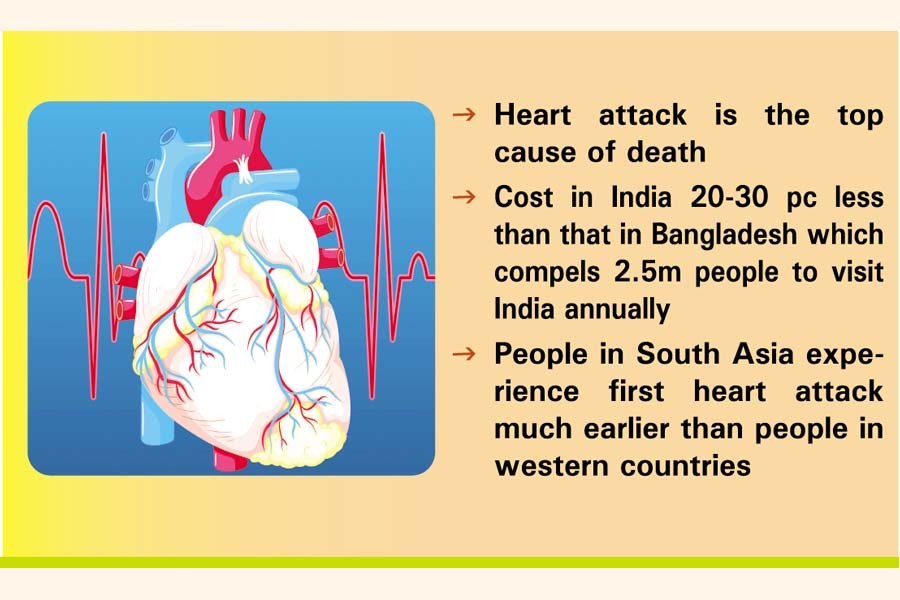
Costly, poor services force patients to seek treatment abroad
SM NAJMUS SAKIB | Tuesday, 12 March 2024

Fifty-one-year-old Hafez Rabiul Alam experienced a severe chest pain last December which had him go through an angiogram, a scan that shows blood flow through arteries or veins.
Alam, a resident of northern Domar Upazila of Nilphamari district, was immediately taken to Rangpur Medical College Hospital where doctors diagnosed a major heart attack.
Alam was lucky enough to dodge the death this time which is the top cause of death in Bangladesh, according to the latest demographic survey. Alam experienced his first heart attack about 14 years before the nation of the US, according to physicians.
The Bangladesh Bureau of Statistics (BBS) listed a total of 15 major causes of deaths. Of all reported deaths in the survey, 17.45 per cent were due to heart attack.
This is followed by respiratory disease accounting for 9.64 per cent of all deaths, according to the latest Bangladesh Sample Vital Statistics 2022 by the BBS.
Respiratory illness, brain stroke and heart disease constitute 36 percent of all deaths. Pneumonia, asthma, liver cancer and kidney diseases remain responsible for more than 15 percent of the total deaths, it added.
Dr Abdullah Wadud Chowdhury, head of the cardiology department at Dhaka Medical College Hospital, told the FE that people in South Asia experience their first heart attack about 10 year before the western nations.
US citizens on average experience their first heart attack in the age of 60 to 65 years old while it is 51 to52 years for Bangladeshis and 52 to 56 years for Indians, he said, citing a global study.
Besides, lack of adequate sleep and low physical movements are among the causes. Low physical movement causes central obesity in the human body. Central obesity is responsible for diseases like diabetes, high blood pressures that ultimately raise the risk of heart attack, he explained.
"We can't control the fact related to our genes but we can address the other facts like physical movement, healthy diets and adequate sleep," he suggested.
Doctors in Dhaka suggested Alam should need cardiac stents. But families of Alam, consulting with their relatives in Dhaka, took him to Chennai of India instead.
"Cardiac specialist in India conducted an angiogram and found a block in his heart. But he didn't require cardiac stents, rather cardiologists conducted a micro-surgery," Alam's daughter Sumaia Akhter told the FE.
Our relatives suggested treatment in India calling their treatment more convenient and cost effective than that in Bangladesh, she added.
According to data from the Indian Ministry of Tourism in 2021, the medical tourists from Bangladesh surged by 83 per cent over the previous three years since 2017 with over 54 per cent who had visited India in 2020 were from Bangladesh.
Dr Tasbirul Islam, chairman, Planetary Health Academia, said there are an estimated 2.5 million people who visit India every year for treatment purposes.
"In 2009, 57 per cent people of the Maldives visited India which has reduced to only 7 per cent now, but such visits from Bangladesh to India increased to 54 per cent from 23 per cent amid an increasing health services cost," he told the FE.
The health service is about 20-30 per cent costlier in Bangladesh than neighbouring India, Dr Islam, also a clinical associate professor and attending Pulmonary and Critical care medicine, Indiana University Health Arnett, added.
According to the available information on their websites, Boston Scientific India Ltd's stent name - Promous Premier (Rs. 30,080- (tax exclusive), Boston Scientific India Ltd stent--Promus Elite--Rs. 30,080, Synergy Boston Scientific Rs. 38,265.07.
However, the same cardiac stents are cost in Bangladesh between the ranges of Tk 73,000 (Promous Premier), Promous Elite Tk 93,000, Tk 140,500 (Synergy Boston Scientific). These are revised prices after the government lowered the prices in December last year.
Patients in Bangladesh believe that doctors here prescribe so many unnecessary tests for disease diagnosis which also push them to seek treatment in India, Nepal and other countries, he continued.
Dr Abdullah Wadud Chowdhury also pointed out to improve the health service capacity further.
Bangladesh has a low doctor-patient ratio (about 5.25 doctors per 10,000 populations) less than the global standard (World Health Organization (WHO) recommends a doctor to population ratio of 1:1,000).
Md Nurul Alam, deputy director at the Directorate General of Drug Administration, told the FE they have revised the price of cardiac stents to benefit the ordinary people and pledged to further reduce the cost of medicines gradually.
Health Minister Samanta Lal Sen recently told doctors of the country that the government is working to take the healthcare facility to the yards of common people.